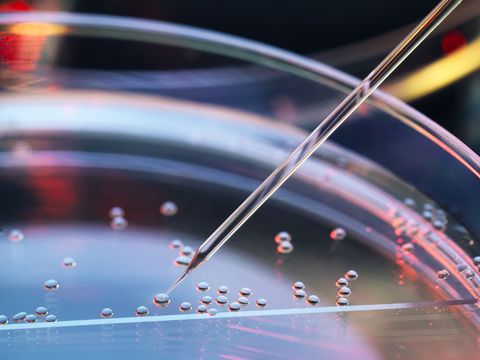
Pop quiz: Stem cells can be used to 1. fight cancer, 2. grow a new kidney, 3. erase wrinkles, or 4. repad creaky knees.
Can’t settle on one answer? Not surprising—the mini powerhouses have grabbed attention lately with studies hinting at their potential to do all of the above.
What makes stem cells so special? Unlike other types of cells, they have the ability to endlessly replicate themselves to replenish tissue. They’re also shape-shifters, capable of transforming into more specialized cells (say, a red blood cell or a lung cell) when they divide.
3,400: The number of ongoing and completed clinical trials using adult stem cells.
This potential to repair and restore has put conditions like multiple sclerosis (MS), arthritis, heart damage, and Alzheimer’s squarely in researchers’ sights. Treatments for these or other disorders could be used on patients within 10 years, says Andrew McMahon, Ph.D., director of the Center for Regenerative Medicine and Stem Cell Research at the University of Southern California—possibly even sooner to ease arthritis pain or regrow cartilage.
Basically, stem cells aren’t a cure-all…yet. (Scientists don’t yet have the ability to grow limbs in labs.) But that hasn’t stopped opportunists from taking advantage of the potential. Hundreds of sketchy clinics have popped up across the country, promising to cure everything from achy backs to cancer using unproven stem cell treatments—with sometimes disastrous results, including tumors and blindness.
Clearly, it’s hard to separate stem cell fact from fiction. Here’s what we know so far about stem cells and what they can (and can’t) do.
Not all stem cells are created equal.
Just as most of us can no longer pull off the backbends of our gymnastic youth (sigh), stem cells are most flexible when they’re young.

Ones taken from a five-day-old human blastocyst (a ball of 150 to 200 cells barely visible to the naked eye) in the lab, for example, can potentially be engineered into every type of cell in the body. Adult stem cells, however—ones extracted from the blood or bone marrow—are more specialized and they can generally only produce cells from their home tissue. Brain stem cells, for example, can become only neurons or glial cells (cells that surround neurons).
But this may soon change. Scientists have figured out how to reprogram adult cells so they’re more like virtual blank slates that could replace any cells that are defective or have been damaged by disease. Hopes are high that within several years, these rejiggered cells could be used to combat many forms of blindness.
They’ve actually been used to battle cancer.
Turns out that the bone marrow transplants used to treat blood cancers such as leukemia and lymphoma are actually a type of stem cell therapy—and it’s been going on for about 50 years.

Here’s how it works: After chemotherapy kills off diseased blood cells, doctors inject the patient with healthy stem cells, typically from a donor. Those cells travel to the bone marrow, where they churn out healthy new blood cells. Clinical trials are underway that look into stem cells’ potential as agents against other cancers.
Autoimmune diseases might be next on their list.
In clinical trials, stem cell transplants have been used to replace the immune system in patients with scleroderma (a rare autoimmune condition that causes hardening of the skin and connective tissues).
Within several years, the same could be true for other conditions in which the immune system attacks itself, such as MS, says Keith Sullivan, M.D., a professor of medicine in the division of cellular therapy at Duke University.
You can actually store stem cells for future use—for a price.
Whether or not to save and store their baby’s cord blood is a complicated question faced today by parents-to-be (you must decide pre-delivery if you want to bank).
The blood taken from a baby’s umbilical cord and the placenta immediately after birth contains stem cells that can be used to treat blood cancers and other disorders—and they may have more uses in the future. But banking comes at a price (typically a few thousand up front, plus up to $300 annually in storage fees), and the blood is rarely used, according to the American Academy of Pediatrics (AAP).
Stem cells have a serious superpower: They’re clone-able.
Instead, the AAP recommends donating your newborn’s cord blood to a public bank. Storage is free and the blood is available to anyone who needs it, including your family. To see if your hospital participates (you have to register in advance), visit BeTheMatch.org.
As for saving your own stem cells for future use, a few adult stem cell banking companies do this (again, it’s pricey), but experts are wary. “We don’t understand enough to say that it makes sense to bank cells now so that they’re available 50 years from now,” says Richard Lee, MD, a professor of stem cell and regenerative biology at Harvard University.
They’re available in your skincare too.
Given their restorative powers, it’s no wonder stem cells (mostly from plants) are finding their way into beauty products. “Stem cells appear to stimulate cell turnover and have strong antioxidant and anti-inflammatory effects, which is great for anti-aging,” says dermatologist Shereene Idriss, M.D., of Union Square Laser Dermatology.
But there’s a catch: The cells need to physically penetrate the skin barrier to work. Enter the celeb fave “penis facial” (yes, you read that right). During the treatment, your skin is microneedled, then lab-grown stem cells identical to those found in the foreskin of infants (read: no babies are harmed) are applied. Tempted to try the $650 cure? Maybe ask for it by its other name: an EGF (epidermal growth factor) facial.
This article originally appears in the November 2018 issue of Women’s Health. For more intel on how to lead a healthier, happier life, pick up an issue on newsstands now.
Source: Read Full Article
